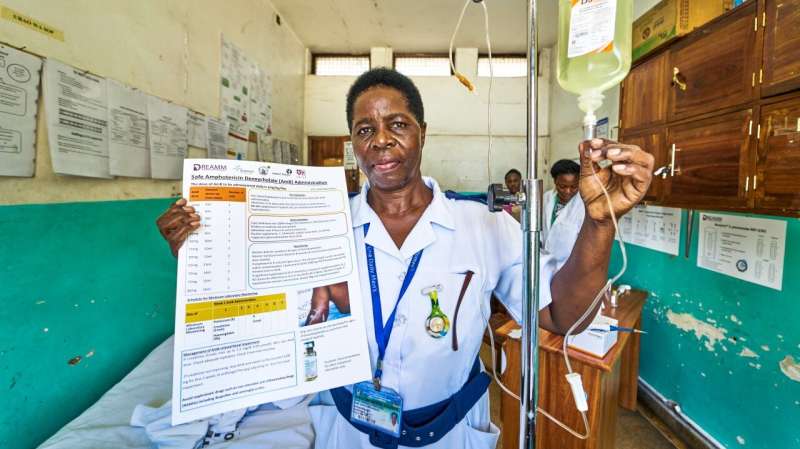Credit: DREAMM, St. George's University of London
Preliminary results presented at the International AIDS Society (IAS) 2021 conference, show that a novel intervention and implementation strategies, including education programs and capacity building can reduce the number of deaths from Central Nervous System (CNS) infections related to HIV.
Led by Dr. Angela Loyse at St George's, University of London, the DREAMM project is run in collaboration with the European & Developing Countries Clinical Trials Partnership (EDCTP) and the French Agency for Research on AIDS and Viral Hepatitis (ANRS). The program aims to reduce mortality linked to HIV-related CNS infections, which are responsible for up to a third of HIV-related deaths, in resource-limited settings in Tanzania, Cameroon, and Malawi after implementation of an intervention and implementation strategies.
The results presented at IAS 2021 focus on the findings from Tanzania, in people living with HIV presenting in a hospital healthcare setting with probable CNS infection, such as meningitis (cryptococcal, tuberculous or bacterial) and/or cerebral toxoplasmosis (a parasitic infection of the brain).
The DREAMM intervention implemented by the team consists of an algorithm with the following key features: bedside diagnostic testing using rapid diagnostic testing (in parallel to standard laboratory-based microbiological tests) and the implementation of WHO-recommended treatments for cryptococcal meningitis from another St George's-led trial. Diagnostic tests and medicines were provided by the project.
Key implementation strategies, under the umbrella of local leadership, included:
- A co-designed, freely accessible online education program, aiming to increase the knowledge of frontline healthcare workers to effectively diagnose and treat HIV-related CNS infections.
- Quality improvement in healthcare delivery including new diagnostic and treatment pathways for patients and laboratory specimens and increased communication between frontline healthcare workers.
- Continued laboratory capacity building and mentorship in management of people living with HIV with advanced HIV disease to improve diagnosis and management of disease.
The team found that, following implementation of their intervention, 2-week all-cause mortality for these patients decreased from 57% (95% CI 44-69) to 29% (95% CI 20-39), while 10-week all-cause mortality decreased from 64% (95% CI 52-76) to 48% (95% CI 38-59).
The researchers note that after intervention, the number of patients receiving diagnostic lumbar punctures dramatically increased, with more patients receiving rapid diagnosis and treatment—which may explain the reduction in deaths.
Speaking on the preliminary results, Dr. Loyse, said, "Our initial findings from Tanzania have shown that the DREAMM intervention and implementation strategies can have a significant impact in reducing mortality from HIV-related infections such as meningitis in resource limited settings.
"While there are still improvements to be made on how to improve pre- and post-hospital care, we hope our findings clearly show that implementation strategies such as education, health system strengthening and mentorship are critical to reduce mortality from AIDS in real-world settings."
The next steps for the team will be to publish the full results across the five sites in Malawi, Cameroon and Tanzania included in the study in a peer-reviewed journal.
Provided by St. George's University of London























